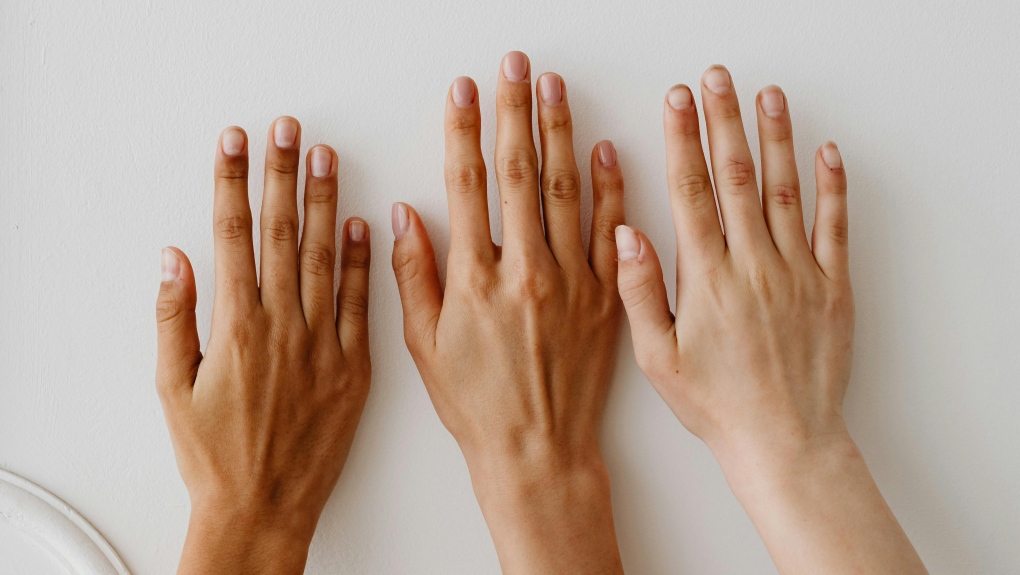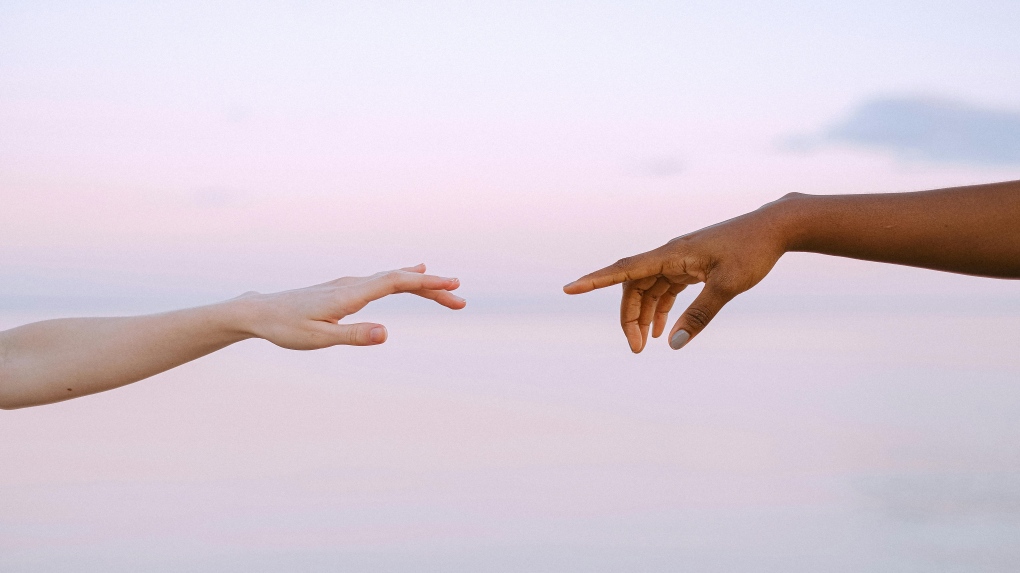What does it mean to be biracial in a multicultural country like Canada?
With her dark hair, dark eyes and otherwise ethnically ambiguous features, Stephanie Gray says she'll never forget what it was like to grow up in small-town Canada in the 1980s.
"It was kind of hard. I really felt like there wasn't anyone in our town that looked like me," she tells CTV News. "I found that I gravitated towards media where there was somebody that kind of looked different...Like, the Babysitters Club, there was Claudia. Even though she wasn't Chinese, I wanted to latch onto somebody to feel like, OK, there isn't something wrong with me."
For all intents and purposes, Gray is a Canadian.
Her great-grandparents moved from China to Canada in 1919, paying the infamous head tax meant to discourage Chinese people from entering the country after the Canadian Pacific Railway was completed.
Now, four generations of Canadian living later, she points out she neither speaks her family's Cantonese dialect nor is her cooking "as good" as her grandmother's.
She adds that her appearance, the blend of a Chinese mother and a Caucasian father, is often puzzling for some.
"If you look at me, I don't look white. I have dark hair, dark eyes," Gray said. "Most people always kind of say, 'oh, what's your background? Where are you from?' They're not sure where to place me, and that's sometimes been hard for me because I'm not Chinese enough to be Chinese...But then, I'm not totally white either."
It's something Gray says she's had to come to terms with as she grew up -- and then, everything she thought she knew about race was turned on its head when she became a mother herself.
"My daughter presents as white. She's got blonde hair. She's got blue eyes," Gray says, adding that many have commented that little Blair must look like her white father. "When you look at her, you would never guess her mother is half Asian."
Gray points out that when her daughter proudly tells people, "I'm Chinese," she is conscious of the fact that some may question that truth because of her big blue eyes.
"She does feel proud of her heritage. I feel good that I've instilled that in her," said Gray. "It's now just as she comes into her own like, OK, you say this, but from my understanding, typically Chinese people look this way, but I don't look that way."
Gray says she now feels an intense need to keep her Chinese traditions alive -- for at least one more generation.
"My cousin has a little girl too, and I gave her her a red packet this year and it was really fun," she said of the Chinese New Year tradition dating back to the Qin Dynasty of 221 BC to 206 BC. "I really just want her to know this is your grandma, this is your great-grandma. This is where they came from. It was difficult for them to come here. They made a lot of sacrifices. I think it's important not to forget that."
One drop too much
Dr. Myrna Lashley, an associate professor in the Department of Psychiatry at McGill University, points out that often when biracial children say they do not feel accepted in either of their cultures, it's due to what others have told them.
She refers to the "one drop" rule, which states that if you have the smallest amount of coloured blood, you are categorized accordingly.
"It's not a matter of you can be Black or white," she tells CTV News. "It's as though whiteness is some kind of reserved area that you can never be if you're 50 per cent Black and 50 per cent white. Why is it that you can only be Black? Why is it that you can only describe yourself as Black?"
 Three hands. (Karolina Grabowska/pexels.com)
Three hands. (Karolina Grabowska/pexels.com)
She notes that intergenerational trauma can also affect how parents raise their children.
"If little Bobby and Tyrone grew up together and they're cousins, but Bobby's white and Tyrone is mix and they go to the store together, well, Bobby's mother doesn't have the need to tell Bobby never leave the store without the cash receipt," Lashley said. "But Tyrone's mom has to make sure that she tells him, 'you're going to be seen as Black. And you're going to be treated as though you're Black, so you don't leave the store without that receipt.'"
Renate Betts, Lashley's daughter, adds it was only ever really pointed out to her that she was biracial when she was with her father.
"I remember being on a Metro platform, holding my dad's hand because you're a kid, there are trains, and people looking at us like, well, what's that about?" she said. "They were curious looking like they thought there was something wrong with this. Was this man abducting me?"
She says this never happened when she was with her mother.
"I think people always just defaulted to, oh, that's the Black lady's kid -- and then random white guy," Betts said.
Saying 'I do'
According to data from the 2011 National Household Survey, 360,045 couples, or 4.6 per cent of all married and common-law couples in Canada, were in mixed unions.
"The 2021 Census of Population does not capture or provide any specific data regarding mixed unions in Canada," notes Julien Abord-Babin, a media relations manager with Statistics Canada. "It is something Statistics Canada may look at again in the future."
 Two hands reach for each other. (Anna Shvets/pexels.com)
Two hands reach for each other. (Anna Shvets/pexels.com)
In addition, 305,075, or 3.9 per cent of all couples, comprised one person who was a member of a visible minority and one who was not, while 54,970 couples (0.7 per cent of all couples) involved two people from different visible minority groups.
"Persons in mixed unions tend to be younger than those in non-mixed unions," Statistics Canada notes.
This is in comparison with 1991 (2.6 per cent), 2001 (3.1 per cent) and 2006 (3.9 per cent).
Is racism over yet?
Looking at how the younger generations have embraced a world outside the binary, Lashley says she has hope that racism and bigotry may soon see its last days.
"Young people aren't as silly as people of my age," she said. "Young people are seeing the stupidity of the whole thing, and how that engendered prejudice and stereotyping harms everybody."
Lashley admits that she, as a person of colour, is not immune to having misconceptions about another person.
"You go somewhere and this person walks in and I always felt, 'Oh, I hope this person is going to feel comfortable in all this, in the sea of blackness,' only to come to realize that this person is of mixed heritage or that they're part of a Black family," she said.
Lashley recalls a story of seeing a white police officer put his hands on a Black child who was walking with three other kids.
"The car drove by, and then the police put on their brakes and reversed and stopped the group. The policeman got out of the car and didn't pay attention to the white kids," she said. "He took the Black kid, actually had him by the scruff of his neck, and other people were around saying, 'oh my God, police brutality, police brutality,' which you would think, and he put him in the car."
She concludes: "It turned out this was his son and he should have been in school. And all you heard the kid saying is, 'don't tell mom, don't tell mom.'"
Lashley says she can laugh about the silliness of it all now, but she laments she's not blind to the fact that race continues to be a defining factor in society.
"I don't believe that colour has any place. That being said, as much as we want to get rid of racism, and I hope to God it comes before I close my eyes, how race is treated is a systemic error," Lashley said. "How people are seen because of their race, because of their colour, that's where the difficulty is."
Echoing her mother's thoughts, Betts adds she believes society is slowly changing its perception of mixed-race people, especially when it comes to putting them in coloured boxes -- but more importantly, she's stopped caring what anybody thinks.
"I loved my father very much and I was not going to allow anyone to take my dad away," Betts said. "For me, if you tell me that I am Black, then you deny that I have a white father."
CTVNews.ca Top Stories

Here's where Canadians are living abroad: report
A recent report sheds light on Canadians living abroad--estimated at around four million people in 2016—and the public policies that impact them.
'We are declaring our readiness': No decision made yet as Poland declares it's ready to host nuclear weapons
Polish President Andrzej Duda says while no decision has been made around whether Poland will host nuclear weapons as part of an expansion of the NATO alliance’s nuclear sharing program, his country is willing and prepared to do so.
Harvey Weinstein hospitalized after return to New York from upstate prison
Harvey Weinstein’s lawyer said Saturday that the onetime movie mogul has been hospitalized for a battery of tests after his return to New York City following an appeals court ruling nullifying his 2020 rape conviction.
Deadly six-vehicle crash on Highway 400 sparked by road rage incident
One person was killed in a six-vehicle crash on Highway 400 in Innisfil Friday evening.
Invasive and toxic hammerhead worms make themselves at home in Ontario
Ontario is now home to an invasive and toxic worm species that can grow up to three feet long and can be dangerous to small animals and pets.
Central Alberta queer groups react to request from Red Deer-South to reinstate Jennifer Johnson to UCP caucus
A number of LGBQT+2s groups in Central Alberta are pushing back against a request from the Red Deer South UCP constituency to reinstate MLA Jennifer Johnson into the UCP caucus.
Opinion I just don't get Taylor Swift
It's one thing to say you like Taylor Swift and her music, but don't blame CNN's AJ Willingham's when she says she just 'doesn't get' the global phenomenon.
Sophie Gregoire Trudeau on navigating post-political life, co-parenting and freedom
Sophie Gregoire Trudeau says there is 'still so much love' between her and Prime Minister Justin Trudeau, as they navigate their post-separation relationship co-parenting their three children.
First court appearance for boy and girl charged in death of Halifax 16-year-old
A girl and a boy, both 14 years old, made their first appearance today in a Halifax courtroom, where they each face a second-degree murder charge in the stabbing death of a 16-year-old high school student.

































